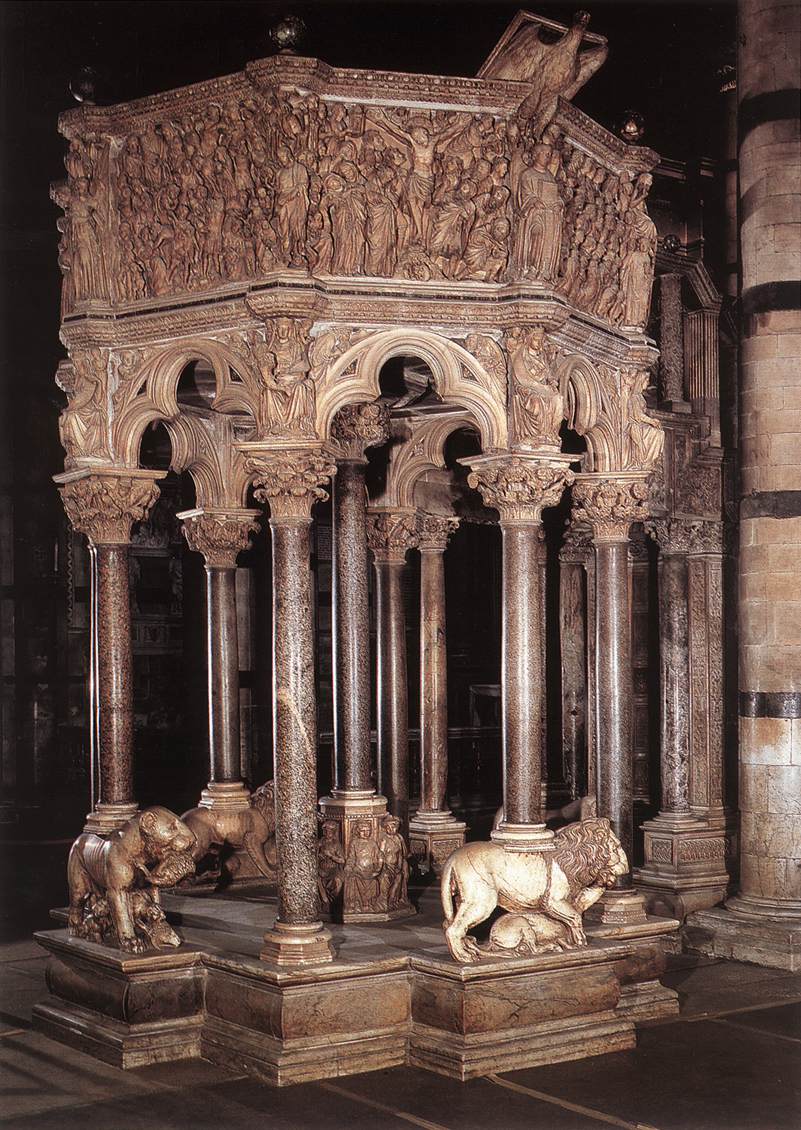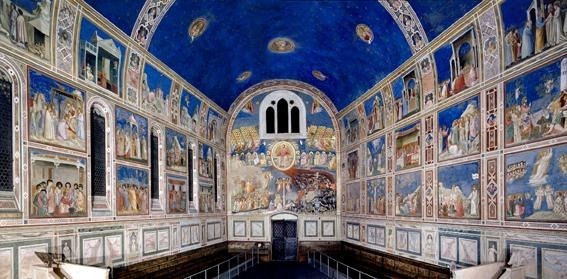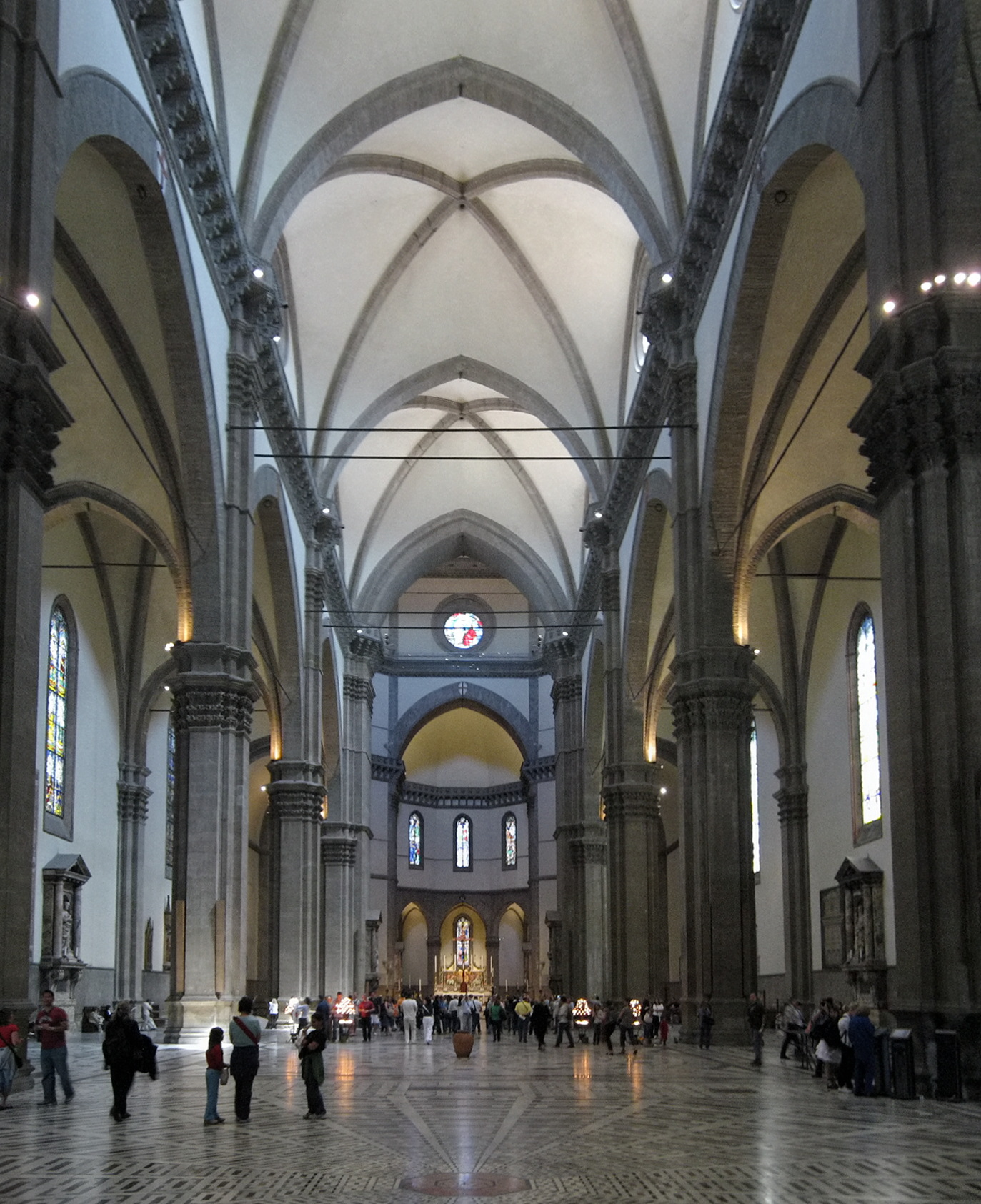ArtHistorySurvey.com Wiki
O.E.R. Collaboration Wiki
History: Italy 1200-1400
Preview of version: 13
Context
Villard de Honnecourt (c. 1200-c. 1250) was a thirteenth-century French artist best remembered for his sketchbook, in which he drew objects, architectural motifs, animals, and people from real life (click here to view the sketchbook; the website is in French, but you can virtually flip through the pages of Honnecourt's sketchebook by clicking on the word "Feuilleter" and then the purple arrows above the drawings). The mere existence of Honnecourt's sketchbook shows how artists were taking a renewed interest in the world around them during the late Gothic period. Also during this time, artists started being known widely and valued as individuals, and they began signing their works.
This era also coincided with invention of moveable type by the German printer-publisher Johann Gutenberg (born 14th century, died 1468), which eventually allowed for the rapid dissemination of knowledge on a scale never seen before. Giorgio Vasari (1511-1574), the Italian artist and writer, would later compare this period to the Renaissance and find it wanting in his highly influential "Lives of the Artists." The "Lives of the Artists" was a series of biographies focused on artists whose accomplishments led up to and were part of the Renaissance, beginning with Giotto, who would become known as the father of the Italian Renaissance, and ending with Michelangelo and Titian.
An increased interest in naturalism - that is, in capturing the world as we see it - can be traced in art through the fourteenth and fifteenth centuries. Scholars were also increasingly engaged with Humanism. Thus this period, what is sometimes called the Proto-Renaissance, was a "rebirth" of classical ideals that led to the modern era. Gutenberg's moveable type allowed publishers to reprint not only the bible, but stories and treatises, especially from ancient Rome and Greece, that had once been forgotten or read only in high social circles.
The study of Humanism was strengthened by the new circulation of ancient philosophies and stories, among other texts, and it inspired people to create a code of civil conduct, as well as new theories about education and scholarship. Humanism focused on the concept of the individual within society and the use of one's own senses in the search for knowledge. Artists also sought fame based on their merits outside the existing guild system. To this point, guilds were associations made up of certain types of merchants and craftsmen. For instance, there was a guild of wool merchants and a guild of armorers in Florence. Before the Renaissance, artists were often lumped in with house painters and carpenters, but during and after the Renaissance, artists created their own guilds and sought recognition as individuals. The enthusiasm for antiquity that began in Italy spread across Europe. Moreover, while Latin remained the official language of the Catholic Church, vernacular (non-religious) literature became more popular and it was printed more frequently. That led to the standardization of the Italian language, which had varied by region until that time. Medieval style and conventions still dominated the way art was made and looked, but there was more of an attempt to break away from such conventions during the 13th and 14th centuries.
City-states came to power during these years as empires broke up in the Romanesque and Gothic eras. In Italy, each city-state was governed by executive bodies, councils, and special commissions. Each kingdom had their own sources for revenue and support, and they all enjoyed the start of an age of economic prosperity. Politics were often tied directly to religious bodies and the Catholic Church, which in turn encouraged many religious commissions.
A break in the Catholic Church, called the Great Schism, occurred in 1305. The Great Schism was sparked when a French pope was appointed and he settled Avignon instead of the traditional Rome. This caused a divide between those who thought the papacy should stay seated in the Vatican, in Rome, and those who objected to the discord they perceived in that Italian center. This tension led both parties to comission propagandistic works in an attempt to sway parishioners.
 Also in the 14th century, the Black Death (Bubonic Plague) eliminated 25 to 50 percent of Europe's population in only around five years. People were witness to diseases and outbreak never witnessed in the history of human civilization. These events led many to seek refuge in Church doctrine.
Also in the 14th century, the Black Death (Bubonic Plague) eliminated 25 to 50 percent of Europe's population in only around five years. People were witness to diseases and outbreak never witnessed in the history of human civilization. These events led many to seek refuge in Church doctrine.
Further Reading
Sculpture: There was an interest in classical sculpture throughout the Middle Ages.


- Nicola Pisano, Pulpit of Pisa Cathedral Baptistry, 1259-1260
Nicola Pisano (1220-1284) was among the first known sculptors to show interest in classical forms and conventions in the late Middle Ages. The marble reliefs and ornament he created for the pulpit for the Bapitstry in Pisa blended medieval traditions with those inspired by antiquity. (The pulpit was the place from which the priest would hold the church service; above left.) The tri-lobed arches and lions were features associated with the Middle Ages, but the round arches and the capitals were based on classical motifs.The bushy capitals Pisano used were variations on the classical Cornithian capital, and the rectangular relief panels he used to clad the pulpit recalled ancient Roman sarcophagi. The panel at the above right, which combines scenes of the Annunciation and the Nativity, is reminiscent of Etruscan and Roman sarcophagi in which figures would lay in a half-reclining pose, like the central figure of Mary here. The figures seem substantial, which also closely resembles classical relief sculpture. Scholars have even been able to find models on sarcophagi that Pisano would have known.
Painting:
- Bonaventura Berlinghieri, Saint Francis Altarpiece, 1235
This altarpiece was created mostly in the Byzantine style: the figure stands in a frontal pose and his body seems relatively flat. The gold background was often used during the Middle Ages to denote the realm of Heaven, so its use here both emphasizes the spiritual nature of the scene and it connects this painting to earlier works. The scenes along the sides contrast with the flat, frontal main figure of Saint Francis; the figures there look more naturalistic and dimensional as they seem to occupy real space.
During this time, religious orders and confraternities became even more important, and they helped spread holy ideas based on the teachings of different saints and those saints' modes of piety. For instance, Saint Francis believed he could come closer to God by rejecting worldly goods. To do so, he stripped himself in a public square and committed himself to a strict life of fasting, prayer, and meditation. It was said that he received the stigmata for his actions. Stigmata were wounds that replicated those received by Christ on the cross, and we see two of Saint Francis's stigmata in his hands. The robes he wears here became the fashion of the Franciscan Order.
Cimabue, Madonna Entroned with Angels and Prophets, 1280-1290
Cimabue (c. 1240-c. 1302) also seemed to respond to the impulse towards naturalism that we saw in Pisano's work. His Madonna Enthroned with Angels and Prophets (above) still looks back to the Byzantine style, with its emphasis on flat, almost geometric planes and symmetry, and the gold used for the background and embellisments. However, Cimabue constructed a deeper space for the Madonna and surrounding figures to occupy than artists in previous periods. Although it still remains part of Byzantine tradition, it hints at some changes future generations of artists would explore.
- Giotto Di Bondone
In his "Lives of the Artists," Vasari introduced Giotto (c. 1267-1337) as the first Renaissance artist. In his book from 1550 (which was later expanded and reprinted in 1568), Vasari wrote about Giotto and that artist's fateful encounter with Cimabue:
NOW IN THE YEAR 1276, in the country of Florence, about fourteen miles from the city, in the village of Vespignano, there was born to a simple peasant named Bondone a son, to whom he gave the name of Giotto, and whom he brought up according to his station. And when he had reached the age of ten years, showing in all his ways though still childish an extraordinary vivacity and quickness of mind, which made him beloved not only by his father but by all who knew him, Bondone gave him the care of some sheep. And he leading them for pasture, now to one spot and now to another, was constantly driven by his natural inclination to draw on the stones or the ground some object in nature, or something that came into his mind. One day Cimabue, going on business from Florence to Vespignano, found Giotto, while his sheep were feeding, drawing a sheep from nature upon a smooth and solid rock with a pointed stone, having never learnt from anyone but nature. Cimabue, marvelling at him, stopped and asked him if he would go and be with him. And the boy answered that if his father were content he would gladly go. Then Cimabue asked Bondone for him, and he gave him up to him, and was content that he should take him to Florence.
- Giotto, Madonna Enthroned, 1310
Giotto filled his painting of the Madonna Enthroned with sturdy figures and architecture. The angles of the throne and the steps in particular show that he was trying to work out a way to capture perspective, or the recession of objects in space. He is not totally successful - the edges of the steps splay outwards instead of following the same orthogonal angle, for instance - but this marks an important shift towards an understanding of how to render objects in real space. The Virgin Mary is still idealized here but her body seems to be substantial under her robes. We even get the sense that Giotto used models for the figures in this altarpiece, since each seems like an individual.
Giotto, Arena Chapel, 1305-1306
Click here for a Smarthistory documentary Part 1, Part 2, Part 3, and Part 4.
Giotto frescoed these murals for a wealthy merchant in a private chapel located near an ancient Roman amphitheatre in Padua, Italy. The main focus of the building was on the interior. Thirty-eight panels, each with a painted frame, illustrates the complete life of Christ. Along the bottom register, Giotto painted panels of faux marble veneer along with allegories of the virtues and vices in grisaille (that is, entirely in gray, black, and white). The vaulted ceiling was painted a vivid lapis blue and dotted with gold stars to represent the realm of heaven. The same blue used in the backgrounds of the scenes of Christ's life. Individual panels are all framed with decorative borders to separate them into registers or levels. Please refer to the above linked videos for the specific descriptions of some of Giotto's innovations.
- Duccio Di Buoninsegna: The Republic of Siena was another that commissioned many artworks. The area demonstrated a devotion to the Virgin as paramount for religious life in this city.
The Maesta Altarpiece (1308-1311): This altarpiece demonstrates a major achievement. It has many panels painted both front and back with a 7’ high central panel by 13’ across. The panels have been removed and are now spread across the world in different museums. The painting has order taken from the Byzantine tradition with rigidity of figures. Duccio, however, individualized the faces and poses, softened the outlines and drapery, though, because of it being a center piece to the church, it limited the amount of experimentation that could be had. He still allowed himself more experimentation on the accompanying panels as can be seen in the Betrayal of Jesus where there is still the sense of religious drama and stage-like setting, however the bodies here also move with more life and form than previous artwork.
Simone Martini, Annunciation (1333): Martini was a pupil of Duccio. He developed what came to be known as an “International Style” based on brilliant color, lavish costumes and ornate ornamentation along with splendid processions and was a counter to Giotto’s style. Martini's paintings consist of a flowing line and weightless figures within space-less settings. Symbol becomes extremely important:- Lilly: Virgin
- Book: Knowledge
- Gesture of modesty
- Blue: Royal (costly color)
- Dove: God
- Duccio Di Buoninsegna: The Republic of Siena was another that commissioned many artworks. The area demonstrated a devotion to the Virgin as paramount for religious life in this city.
-
There in a little time, by the aid of nature and the teaching of Cimabue, the boy not only equalled his master, but freed himself from the rude manner of the Greeks, and brought back to life the true art of painting, introducing the drawing from nature of living persons, which had not been practised for two hundred years; or at least if some had tried it, they had not succeeded very happily. Giotto painted among others, as may be seen to this day in the chapel of the Podestà's Palace at Florence, Dante Alighieri, his contemporary and great friend, and no less famous a poet than Giotto was a painter.(Vassari)
We see the high pedestal that Vassari places this artist in relation to the transition from the Gothic era to the Renaissance. Vassari notes the naturalism that is demonstrated from observation. He also presumes Cimabue to be his teacher and it is also presumed that he could have been influenced by many different styles or people, but the outcome is a major shift in expression. According to Vassari, Giotto is almost solely responsible for displacing Byzantine style, establishing painting as a major art form, and restoring a naturalistic approach which had been abandoned. This also expressed the dominance of sight for gaining knowledge of the world which pushed the early scientific revolution.
Pietro Lorenzetti, The Birth of the Virgin (1342): Lorenzetti was also a pupil of Duccio. His work demonstrates a search for convincing spatial illusions. This was painted for a Cathedral as part of a series honoring the Virgin Mary. The painting seems a sort of diorama of the narrative. Characters are even cut by the architecture giving mor sense of a space. This was a large step in integrating architectural illusionism with the figure.
Ambrogio Lorenzetti, Peaceful City (From: Effects of Good Government in the City and in the Country) (1338-1339): Ambrogio was the brother of Pietro and also a student of Duccio. These paintings were done as a part of a series of frescos that are in the public house of Siena, Italy. The series represents the effects of good and bad government done as a sort of reminder by those in charge to keep with the program. The mural project gave the artist the chance to study everyday life and use it as metaphor. It also gave the artist the chance to practice new ideas of perspective in depicting the cityscape and landscape in the paintings of the effects on the country.
Architecture
- The Republic of Florence: Florence was another dominant city-state during the 14th century they demonstrated great pride due to their wealth from textile and creating the Florin as a monetary standard.



Arnolfo Di Cambio – Florence Cathedral (1296): Intended as the “most beautiful and honorable church in Tuscany.” The exterior modelled in the Tuscan fashion of marble-encrusted geometric design to match the Baptistry of San Giovani seen before. It demonstrated itself as very different from the Gothic structures being built. There is no emphasis on the vertical, no sense of stone tracery, no flying buttresses and it clings to the ground with an emphasis on horizontal elements. The geometric patterning suggests an emphasis on classical proportions. The dome, designed by Filippo Brunelleschi (1420-1436) is known to be a monument to the Renaissance.
The nave was designed with the idea of spaciousness and a focus on the Altar as the horizontal drive pushes the eye to the end of the hall. It was designed to fit as much of the population as possible so the Aisles become a part of the nave. The piers also show off their supporting function.
Giotto di Bondone - Campanile of the Florence Cathedral (1334): The bell tower was designed by a painter. It stands apart from the cathedral in Italian tradition. Gothic towers tend to shoot upward as one continuous element though this tower is subdivided into cubic sections becoming the sum of its parts. The Renaissance idea was to create structures that were developed as the sum of parts where each part was individual yet beautiful and logically worked with the whole. Thus there is less emphasis on emotion and more on intellect.
Notes
This module was produced by Professor Josh Yavelberg utilizing a mixture of open educational resources and notes from:
Kleiner, Fred. Gardner's Art through the Ages: The Western Perspective,|. Vol. 2. Cengage Learning, 2013.
